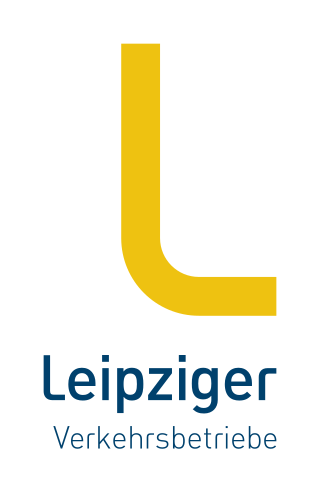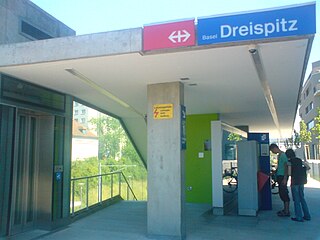
The Leipziger Verkehrsbetriebe (LVB), literally translated into English as the Leipzig Transport Authority, operates the tramway and bus transport services in Leipzig, Germany. The LVB network is a part of the regional public transport association, the Mitteldeutscher Verkehrsverbund (MDV). The LVB was formed by the merger, from 1 January 1917, of two predecessor undertakings, the Großen Leipziger Straßenbahn and the Leipziger Elektrischen Straßenbahn. The merged undertaking was also known as GLSt until it was reorganized and renamed as the LVB, from 29 July 1938.
Baselland Transport AG (BLT) is a Swiss public transport operator in the cantons of Basel-Land, Basel-Stadt, Solothurn and in France. The BLT was founded in 1974, and is owned by the Canton of Basel-Land, located to the south of the city. It transports some 48 million passengers per year, using a fleet of 64 buses and 100 trams over a network of 165 kilometres (103 mi) of bus routes and 65 kilometres (40 mi) of tram routes.

BLT's tram line 10 is an international tramway line in Europe which is 25.6 kilometres (15.9 mi) in length. The line in the region of Basel, Switzerland, is operated by Baselland Transport (BLT).

Trams in France date from 1837 when a 15 km steam tram line connected Montrond-les-Bains and Montbrison in the Loire. With the development of electric trams at the end of the 19th century, networks proliferated in French cities over a period of 15 years. Although nearly all of the country's tram systems were replaced by bus services in the 1930s or shortly after the Second World War, France is now in the forefront of the revival of tramways and light rail systems around the globe. Only tram lines in Lille and Saint-Étienne have operated continuously since the 19th century; the Marseille tramway system ran continuously until 2004 and only closed then for 3 years for extensive refurbishment into a modern tram network. Since the opening of the Nantes tramway in 1985, more than twenty towns and cities across France have built new tram lines. As of 2024, there are 28 operational tram networks in France, with 3 more planned. France is also home to Alstom, a leading tram manufacturer.

The Waldenburg railway is a narrow-gauge light rail system in the canton of Basel-Landschaft, Switzerland. The 13.1-kilometre (8.1 mi) long single-track line runs from Liestal, the capital of the canton, to Waldenburg, with stops in Bubendorf, Hölstein, Niederdorf, and Oberdorf. It connects to SBB train services in Liestal railway station. The line was temporarily closed between April 2021 and December 2022 for modernisation and conversion to metre gauge.

The Flexity 2 is a family of tram or light-rail vehicle manufactured by Bombardier Transportation. It is 100% low-floor, in order to easily accommodate wheelchairs and pushchairs. The trams are bi-directional, with cabs at both ends and doors on both sides, and are articulated with five or seven sections. This family of trams debuted on the Blackpool Tramway, England.

The Basel tramway network is a network of tramways forming part of the public transport system in Basel, Switzerland, and its agglomeration - it also reaches into adjacent suburbs in Germany and France. The only two other tramway networks to cross an international border are Geneva's and Strasbourg's tramways. The Basel tram system consists of 12 lines. Due to its longevity, it is part of Basel's heritage and, alongside the Basel Minster, is one of the symbols of the city.

The Neuchâtel tramway is a tramway forming part of the public transport system in Neuchâtel, a city in Switzerland.

The Basel trolleybus system was part of the public transport network of Basel, Switzerland, for nearly six decades. Opened in 1941, it combined after 1997 with the Basel Regional S-Bahn, the Basel tramway network and Basel's urban motorbus network to form an integrated all-four style scheme until its closure in 2008.

Liestal railway station is a railway station in Switzerland, in the municipality of Liestal and canton of Basel-Landschaft. The station is on the Swiss Federal Railway's Hauenstein main line, which connects Basel and Olten. It is served by five trains per hour to Basel, four trains per hour to Olten, and hourly trains to Interlaken, Lucerne, and Zürich. Several trains a day operate through to Frankfurt and Berlin. The station is also the junction for, and terminus of, the Waldenburg narrow gauge railway, which operates a train service every ten or twenty minutes to Waldenburg. The Waldenburg line closed in April 2021 until December 2022 for conversion to 1,000 mm gauge. Since 2019, the Swiss Federal Railways has been undertaking renovation and expansion works at Liestal which were commissioned by the federal government and which are due to be completed in 2025.

The Tarifverbund Nordwestschweiz, also known by its initialisation TNW, is a Swiss public transport tariff network covering the whole of the cantons of Basel-Stadt and Basel-Landschaft, together with parts of the cantons of Aargau, Jura and Solothurn.

Weil am Rhein station is a small railway junction in Weil am Rhein in the German state of Baden-Württemberg on the German-Swiss border. The Weil am Rhein–Lörrach railway branches off the Mannheim–Karlsruhe–Basel railway at the station. From 1878 to 1937, the station was the starting point of the Weil am Rhein–Saint-Louis line to the French town of Saint-Louis.

Basel Dreispitz railway station is a railway station in the city of Basel, in the Swiss canton of Basel-Stadt. It is an intermediate stop on the Basel–Biel/Bienne line and is served by local trains only. The station was built in 2005 despite numerous objections from local residents and was opened in May 2006. In 2008 the station was awarded a Brunel Award by the Watford Group. It offers transfer possibilities on tram lines of Baselland Transport as well as bus lines of the same company and the Basler Verkehrs-Betriebe.

The Basel–Dornach railway line is a 1,000 mm railway line in Switzerland. It runs 6.2 kilometres (3.9 mi) from Dornach-Arlesheim to the border of Basel-Stadt, near Basel Dreispitz, where it connects with the Basel tram network. The line was built by the Birseckbahn in 1902 and is now owned by Baselland Transport, which operates Line 10 of the Basel tram network over the line.

The Basel–Aesch railway line is a 1,000 mm railway line in Switzerland. It runs 8.2 kilometres (5.1 mi) from Aesch to the border of Basel-Stadt, near Basel Dreispitz, where it connects with the Basel tram network. The line was built by the Trambahn Basel-Aesch in 1907 and is now owned by Baselland Transport, which operates Line 11 of the Basel tram network over the line.

The Basel–Pratteln railway line is a 1,000 mm railway line in Switzerland. It runs 6.2 kilometres (3.9 mi) from Pratteln to the border of Basel-Stadt, across the river Birs from St. Jakob-Park, where it connects with the Basel tram network. The line was built by the Basellandschaftliche Ueberlandbahn in 1921 and is now owned by Baselland Transport. Basler Verkehrs-Betriebe operates line 14 of the Basel tram network over the line.

The Basel–Rodersdorf railway line is a 1,000 mm railway line in Switzerland and France. It runs 16.2 kilometres (10.1 mi) from Rodersdorf, in the Swiss canton of Solothurn, to the border of Basel-Stadt, near the Basel Zoo, where it connects with the Basel tram network. The line crosses through the southern part of the French department of Haut-Rhin, serving the commune of Leymen. The line was built by the Birsigthalbahn-Gesellschaft in stages between 1887 and 1902 as a conventional steam-hauled line. It was later electrified, and is now owned by Baselland Transport, which operates lines 10 and 17 of the Basel tram network over the line.




















